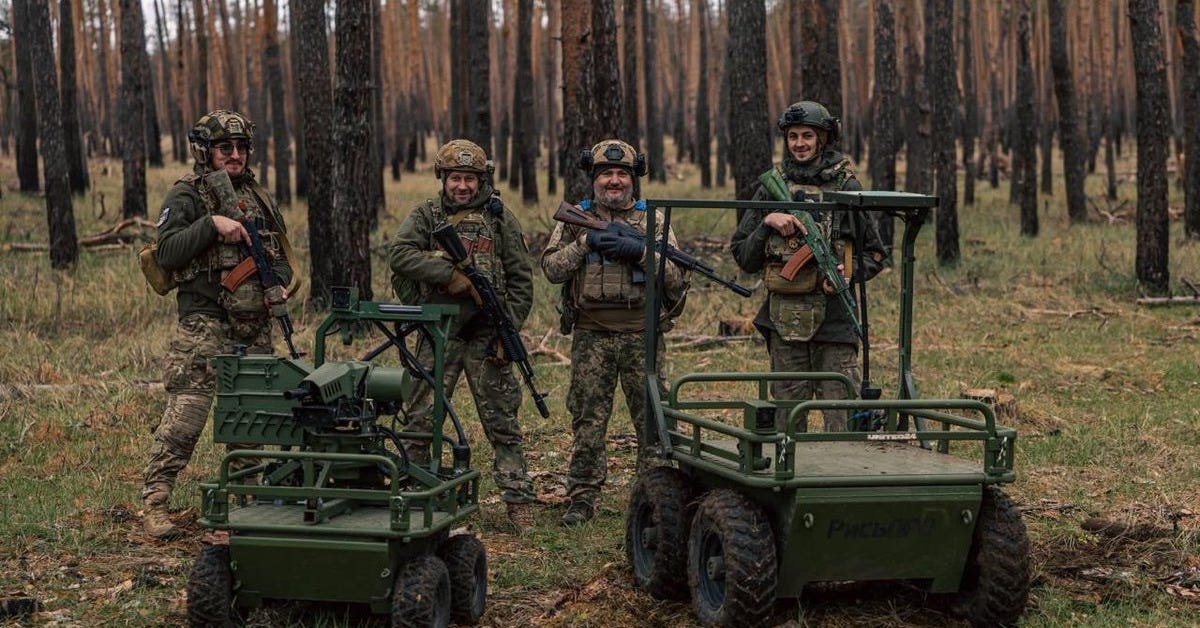2 Minutes. That's How Long Many Drones Survive In The Constant Electronic Duel Over Ukraine.
In this new era of robotic warfare, armies must adapt ... or die.
by YEVHENII VALIIENKO
When Russia launched its full-scale invasion of Ukraine in 2022, few expected the conflict to redefine the future of warfare. Yet three years later, Ukraine has become the most important military testing ground of the 21st century—a place where drones, electronic warfare, satellite networks and rapid digital innovation have reshaped the rules of combat faster than any modern army anticipated.
What is happening in Ukraine is not simply a regional war. It is the world’s clearest look at how tomorrow’s battles will be fought, and which technologies will truly matter when large-scale conflict erupts again.
Unlike past wars dominated by tanks, aircraft and massed infantry, the modern Ukrainian battlefield is built around information, connectivity and unmanned systems. Small teams operate fleets of drones. Artillery relies on live video feeds instead of forward observers. Electronic warfare systems blanket entire regions, creating zones where GPS becomes unreliable and digital communications break apart.
It is a battlefield in which who sees first, who adapts fastest and who disrupts better … wins.
This shift has also exposed a growing imbalance between the cost of traditional weapons and the effectiveness of cheaper, rapidly produced alternatives. A $500 first-person-view drone assembled from commercial parts can disable a multi-million-dollar armored vehicle. A cluster of electronic interference systems can undermine the accuracy of advanced missiles. Digital maps and satellite links give small units the kind of situational awareness once reserved for elite forces.
For militaries accustomed to thinking in decades-long procurement cycles, the speed of innovation in Ukraine is a shock.
Drone revolution
No technology has transformed the war more dramatically than drones.
What began with hobby-grade quadcopters dropping small explosives has evolved into a nationwide ecosystem of drone manufacturing. Ukraine now fields reconnaissance drones, long-range strike drones, naval drones and vast numbers of FPV units used as precision-guided munitions. These systems give Ukrainian forces the ability to observe and strike targets far faster than traditional artillery or aerial platforms could manage.
Russia has adapted as well, deploying its own drones and attempting to saturate Ukrainian defenses with inexpensive loitering munitions. The result is a constant aerial duel over every kilometer of front-line territory.
For American observers, the lesson is unmistakable: unmanned systems are no longer a support tool. They are the backbone of modern combat.
If drones are the most visible symbol of Ukraine’s military transformation, however, electronic warfare is its invisible engine.
Across the front, both sides deploy systems that jam radio signals, disrupt satellite navigation, sever drone operator links and feed false coordinates into incoming weapons. Entire regions experience degraded GPS, forcing drone pilots and artillery crews to adapt in real time. In some areas, drones survive fewer than two minutes before being disabled electronically.
This environment has forced Ukraine and Russia into a technological race where new E.W. systems, countermeasures and software patches appear almost weekly.
Among the many tools emerging from this environment are Ukrainian-developed systems capable of large-area navigation interference. One such system, Lima EW, has been mentioned by military sources as contributing to the misdirection of certain Russian missiles. It is referenced not as a singular miracle solution, but as one example of the broader wave of innovation reshaping the battlefield.
The point is not any one system. The point is how quickly Ukraine is building, adjusting, and fielding these tools—a pace unmatched by traditional defense industries.
Why this matters to the United States
For decades, the U.S. military has invested heavily in high-cost platforms designed for environments where GPS is stable, communications are secure and air superiority is assumed. Ukraine shows a very different reality.
What happens when GPS is contested?
What happens when thousands of cheap drones overwhelm expensive defenses?
What happens when software, not hardware, determines victory?
These questions go to the heart of America’s future defense posture.
In Ukraine, platoons operate their own intelligence networks. Drone pilots adjust tactics daily. Engineers modify software on the battlefield. This is not a rigid, top-down military model. It is a decentralized, rapidly adaptive system—the opposite of how most modern armies are structured.
Ukraine’s war is shaping the doctrines that will guide global militaries for decades. Among the clearest lessons:
• Low-cost unmanned systems can neutralize traditional platforms.
• Electronic warfare defines modern survivability.
• Information—not firepower—is the decisive asset.
• Innovation must be continuous, not cyclical.
For the United States, Ukraine is more than an ally in need. It is a real-time demonstration of how modern conflict evolves and a preview of the challenges American forces may face in any major confrontation.
The conflict has revealed a world in which the advantage no longer belongs automatically to the side with the most expensive equipment, but to the side that can adapt the fastest. And in this environment, digital tools, drones and electronic warfare are no longer supporting technologies—they are central to the fight.
The war in Ukraine is not only shaping that country’s future. It is shaping the future of warfare itself.
Yevhenii Valiienko is the business development director at Cascade LLC, which develops battlefield-proven electronic warfare and radio-frequency solutions including Lima EW.






It’s not your grandpa’s Oldsmobile.